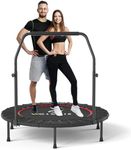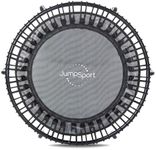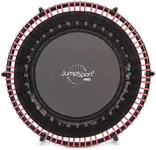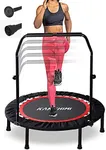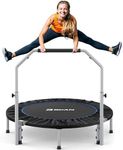Buying Guide for the Best Rebounder
Choosing a rebounder, also known as a mini trampoline, is all about matching your fitness goals, available space, and comfort preferences. Rebounders are popular for low-impact cardio workouts, lymphatic health, and even fun family exercise. To find the best fit, you’ll want to consider how you plan to use it, who will be using it, and where you’ll keep it. Understanding the key features will help you make a confident choice that supports your health and lifestyle.Size (Diameter)The size of a rebounder is measured by its diameter, which affects both the jumping area and how much space it will take up in your home. Smaller rebounders (around 36 inches) are more compact and easier to store, making them great for tight spaces or quick workouts. Medium sizes (about 40 inches) offer a balance between space and comfort, suitable for most users. Larger rebounders (45 inches or more) provide more room to move and are ideal if you want extra stability or plan to do a wider range of exercises. Think about your available space and how much movement you want during your workouts to pick the right size.
Weight CapacityWeight capacity tells you the maximum user weight the rebounder can safely support. This is important for safety and durability. Lower capacity models (up to 200 lbs) are suitable for lighter users or children, while mid-range (200–300 lbs) covers most adults. Heavy-duty rebounders (over 300 lbs) are designed for higher weights or for those who want extra reassurance about sturdiness. Always choose a rebounder with a weight limit above your own weight to ensure safe and long-lasting use.
Bounce Mechanism (Springs vs. Bungee Cords)Rebounders use either metal springs or bungee cords to create the bounce. Spring-based rebounders tend to offer a firmer, higher bounce and are often more affordable, but they can be noisier and sometimes less gentle on joints. Bungee cord rebounders provide a softer, quieter, and smoother bounce, which is easier on the joints and preferred for longer workouts or rehabilitation. If you want a gentle, quiet experience, look for bungee cords; if you prefer a firmer, more energetic bounce, springs might be your choice.
Stability FeaturesStability features include things like non-slip feet, a sturdy frame, and sometimes a handlebar for extra support. These features are important for safety, especially if you’re new to rebounding, have balance concerns, or plan to do vigorous exercises. If you want extra confidence while jumping, look for a rebounder with a handlebar or wide, stable legs. If you’re experienced and want a more compact model, you might not need these extras.
Portability and StoragePortability and storage options refer to whether the rebounder can be folded or easily moved. Some rebounders fold in half or even into quarters, making them easy to store under a bed or in a closet. Others are fixed and require more permanent space. If you have limited space or want to move your rebounder between rooms, a foldable or lightweight model is best. If you have a dedicated workout area, a non-folding, heavier rebounder may offer more stability.
Mat Material and QualityThe mat is the surface you jump on, and its material affects comfort, durability, and safety. High-quality mats are made from strong, UV-resistant materials that can handle repeated use without stretching or tearing. Cheaper mats may wear out faster or feel less comfortable. If you plan to use your rebounder frequently or for intense workouts, look for a mat made from premium materials. For occasional or light use, a standard mat may be sufficient.


